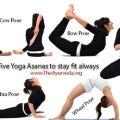Are You Ready for Advanced Yoga? 6 Key Signs to Consider
Yoga offers a multitude of benefits, from improving flexibility and balance to enhancing mental clarity and emotional stability. However, reaching the advanced level of yoga requires more than just physical strength and endurance. It involves a deeper understanding of both body and mind. But how do you know if you’re ready to take that leap? Here are six critical signs that can help you determine if you’re prepared to transition into advanced yoga practice.
1. Mastery of Foundational Poses
The journey to advanced yoga begins with mastery over foundational poses. Many yoga practitioners attempt to jump into advanced postures too quickly, which can lead to improper form, injury, or frustration. If you can consistently and accurately perform foundational poses such as Downward Dog, Warrior II, and Chaturanga, you may be ready to progress.
- Can you hold basic poses without losing form or balance?
- Are your transitions between poses smooth and controlled?
- Do you experience minimal strain or discomfort in these positions?
Solution: Focus on refining these core poses before tackling more complex asanas. Attend beginner and intermediate classes to receive guidance on adjustments and corrections. Utilize props if necessary to ensure your form is accurate.
2. Ability to Focus on Breath Control
Advanced yoga isn’t just about mastering difficult postures; it’s about controlling your breath. Pranayama, or breath control, is integral to yoga at all levels, but its significance becomes even more pronounced in advanced practices. Proper breath regulation allows for better flow, concentration, and body awareness during challenging poses.
- Are you familiar with breath retention techniques such as kumbhaka?
- Can you sync your breathing with movements effortlessly?
- Do you regularly practice breath-focused exercises such as Ujjayi or Nadi Shodhana?
Solution: Practice regular pranayama exercises alongside your yoga routine. Start by incorporating simple techniques such as alternate nostril breathing and gradually advance to more complex patterns of breath control.
3. Strong Mind-Body Connection
A deep understanding of the mind-body connection is vital for progressing to advanced yoga. This awareness allows you to listen to your body, recognize its limits, and adjust your practice accordingly. It’s not about forcing yourself into poses, but about finding balance between effort and ease.
- Are you able to tune in to your body’s signals and avoid pushing yourself into injury?
- Can you maintain mental focus during longer or more challenging sequences?
- Do you experience mindfulness, not just on the mat, but in daily life?
Solution: Integrate mindfulness practices such as meditation into your routine to strengthen this connection. This will enhance your ability to remain present and attentive during difficult postures.
4. Flexibility Paired with Strength
Flexibility is a common goal in yoga, but it’s important to balance it with strength. Advanced poses often require a combination of both, and lacking one can lead to poor form or injury. Key indicators include being able to perform backbends and inversions without strain, while also maintaining core and upper body strength.
- Can you execute deep stretches like Hanumanasana (splits) without pain?
- Do you have the core strength necessary for arm balances like Bakasana (Crow Pose)?
- Can you maintain muscle engagement even during relaxed or passive stretches?
Solution: Develop a balanced practice that incorporates both strength-building and flexibility exercises. Pay special attention to your core and shoulders, as these areas are critical for many advanced postures.
5. Emotional Resilience and Patience
Advanced yoga challenges both your body and your mind, and it requires emotional resilience. You may not master complex poses immediately, and that’s okay. It’s about enjoying the process and understanding that the journey matters more than the destination. Frustration and impatience can hinder your progress, making emotional balance crucial.
- Can you remain calm when struggling with a difficult pose?
- Do you resist the urge to compare your practice with others?
- Are you patient with your body’s limitations and gradual progress?
Solution: Develop a mindset of non-attachment to the outcome. Focus on the effort you put into each practice and celebrate small victories rather than immediate mastery. Consider incorporating santosha (contentment) into your practice.
6. Consistent Practice and Dedication
One of the clearest signs that you’re ready for advanced yoga is the consistency and dedication you bring to your practice. This doesn’t mean practicing for hours every day, but it does mean committing to regular sessions and continuously seeking growth, whether through classes, workshops, or personal study.
- Are you practicing at least 3-4 times per week?
- Do you seek out new challenges in your practice, such as workshops or advanced classes?
- Are you dedicated to deepening your knowledge of yoga, beyond the physical postures?
Solution: Establish a routine that balances time on the mat with off-mat learning. Dedicate yourself to continuous improvement, and don’t be afraid to seek out teachers or mentors who can offer you guidance as you progress.
Key Concepts in Advanced Yoga
To deepen your understanding of whether you’re ready for advanced yoga, let’s explore some of the core concepts:
- Asana: The physical practice of yoga postures.
- Pranayama: Breath control techniques to enhance mindfulness and physical endurance.
- Drishti: Focused gaze to improve concentration and balance in postures.
- Bandhas: Energy locks that help to direct and control prana, or life force.
- Vinyasa: Linking breath with movement to create a fluid sequence of poses.
Historical Context of Advanced Yoga
The practice of yoga has evolved significantly over thousands of years. Originally rooted in ancient Indian spiritual traditions, it was designed to align the body and mind for meditation. Advanced yoga practices, such as intricate poses and breath techniques, were developed as tools for achieving higher states of consciousness. While today’s practitioners may approach yoga for fitness or relaxation, the historical emphasis on mindfulness and breath control remains integral, especially at advanced levels.
Current State Analysis of Advanced Yoga Practice
Advanced yoga has gained popularity worldwide, with an increasing number of practitioners seeking more challenging sequences and poses. Modern yoga studios now offer specialized workshops and teacher trainings that focus on advanced techniques. However, there’s also concern that the emphasis on physically demanding postures might overshadow the mental and spiritual components of yoga. This shift has led to a debate about the purpose and direction of advanced yoga practice in contemporary culture.
Practical Applications of Advanced Yoga
Advanced yoga offers benefits that extend beyond the mat:
- Mental Clarity: By developing greater mindfulness and breath control, practitioners can experience improved mental focus and emotional regulation.
- Physical Strength: Advanced asanas improve muscle tone, flexibility, and endurance, promoting overall physical health.
- Stress Reduction: The meditative aspects of advanced yoga help to reduce stress, leading to better sleep and emotional well-being.
- Holistic Health: Combining asanas, pranayama, and meditation contributes to a more holistic approach to wellness.
Case Studies: Transformation Through Advanced Yoga
| Practitioner | Challenge | Solution | Result |
|---|---|---|---|
| John | Struggled with anxiety | Incorporated regular breathwork and meditation | Reduced anxiety and improved focus |
| Anna | Stiffness in hamstrings | Focused on consistent flexibility work | Improved flexibility and balance |
| Maria | Low energy levels | Implemented advanced pranayama techniques | Increased energy and endurance |








